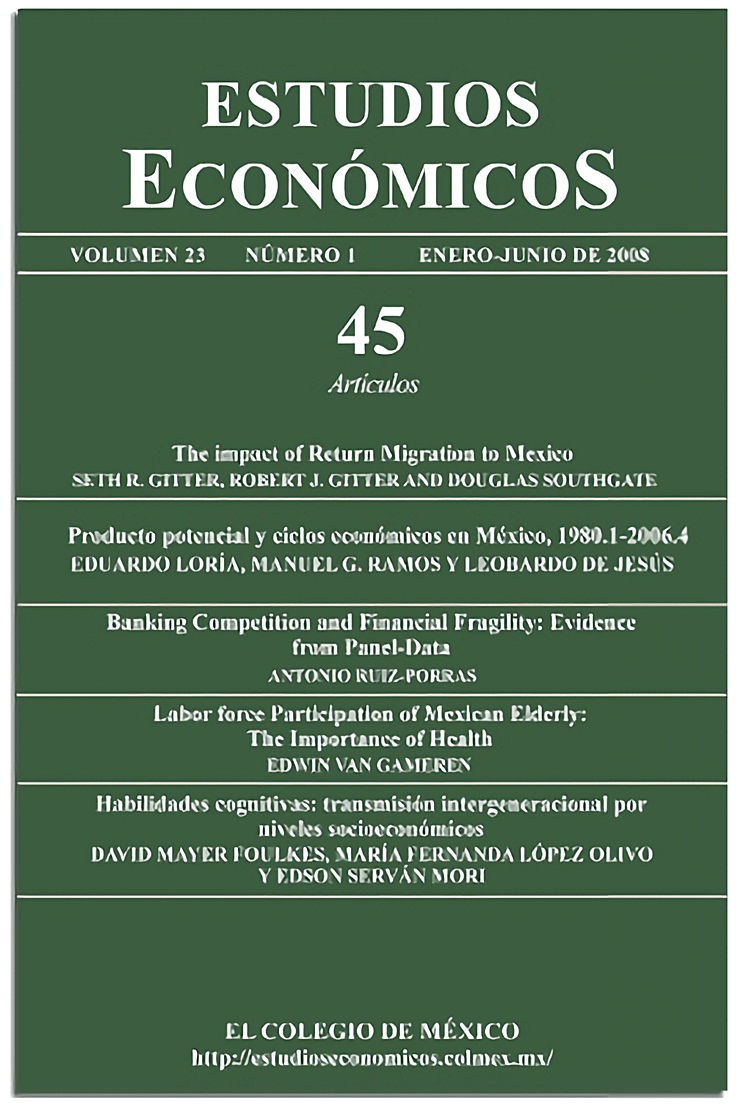Articles
Published 2008-01-01
Keywords
- potential output,
- output gap,
- business cycles,
- structural time series models,
- Kalman filter
How to Cite
Loría, E., Ramos, M. G., & De Jesús, L. (2008). Potential product and economic cycles in Mexico, 1980.1-2006.4. Estudios Económicos De El Colegio De México, 23(1), 25–47. https://doi.org/10.24201/ee.v23i1.139
Abstract
Through the use of Structural Times Series Models we estimated: potential output, the output gap and the business cycles for the Mexican GDP (1980.1-2006.4). We found that: a) the potential output has varied sharply for two different time periods: 2.1% (1980.4-1994.4) and 3.7% (1995.4-2006.4); b) great component of seasonality: Q1 and Q3 are of slow growth (below average) and Q2 Q4 above average; c) we detected that the peaks and troughs have been progressively less pronounced since the year 2000.
Downloads
Download data is not yet available.
References
- Baeza, W. (2004). Brecha del producto: una medida basada en modelos, Banco Central de Chile.
- Ball, L. y G. Mankiw (2002). The NAIRU in Theory and Practice, Journal of Economic Perspectives, vol. 16, núm. 4.
- Caloca, O., A. Cárdenas y J. Ortiz (2004). La brecha del producto en México, 1987-2004, Análisis Económico, año XIX, núm. 40.
- Cerra, V. y S. Chaman (2000). Alternative Methods of Estimating Potential Output and the Output Gap: An Application to Sweden, IMF Working Paper, WP/00/59, IMF.
- Cochrane, J. H. (1988). How Big is the Random Walk in GDP?, The Journal of Political Economy, vol. 96, núm. 5.
- Cuevas, M. A. (2002). Potential GDP Growth in Venezuela. A Structural Time Series Approach, Policy Research WP, núm. 2826, Banco Mundial.
- Doornik, J. y H. Hansen (1994). An Omnibus Test for Univariate and Multivariate Normality, Nuffield College, Oxford, (mimeo), http://www.doornik.com/research/normal2.pdf.
- Durbin, J. y S. J. Koopman (2000). Time Series Analysis by State Space Methods, Oxford University Press.
- Enders, W. (2004). Applied Econometric Time Series, 2a ed., Wiley & Sons Inc.
- Granger, C. W. J. y P. Newbold (1974). Spurious Regressions in Econometrics, Journal of Econometrics, vol. 2, núm. 2.
- Hamilton, J. D. (1994). Time Series Analysis, Princeton University Press.
- Harvey, A. C. (1989). Forecasting Structural Time Series Models and the Kalman Filter, Cambridge University Press.
- Harvey, A. C. (2000). Trend Analysis, University of Cambridge.
- Harvey, A. C. (2001). Testing in Unobserved Components Models, Journal of Forecasting, vol. 20, núm. 1.
- Harvey, A. C. (2002). Trends, Cycles and Convergence, WP 155, Banco Central de Chile.
- Harvey, A. C. (2004). Forecasting with Unobserved Components Time Series Models, en G. Elliot, C. W. J. Granger y A. G. Timmermann (eds.) Handbook of Economic Forecasting, North Holland, vol. 1.
- Harvey, A. C. y S. J. Koopman (1997). Trends and Cycles in Multivariate Time Series, en C. Heij, et al. (eds.), System Dynamics in Economic and Financial Models, Wiley.
- Harvey, A. C. y A. Jaeger (1993). Detrending, Stylized Facts and the Business Cycle, Journal of Applied Econometrics, vol. 8, núm. 3.
- Harvey, A. C. y T. Trimbur (2001). General Model-Based Filters for Extracting Cycles and Trends in Economic Time Series, The Review of Economic and Statistics, vol. 85, núm. 2.
- Haavelmo, T. (1944). The Probability Approach in Econometrics, Econometrica, 12, suplemento.
- Hendry, D. F. (1980). Econometrics: Alchemy or Science?, Economica, New Series, vol. 47, núm. 188.
- Hodrick, R. y E. C. Prescott (1997). Postwar US Business Cycles: An Empirical Investigation, Journal of Money, Credit, and Banking, vol. 29, núm. 1.
- Kalman, R. (1960). A New Approach to Linear Filtering and Prediction Problems, Journal of Basic Engineering, Transactions ASMA, Series D, 82.
- Kichian, M. (1999). Measuring Potential Output within a State-Space Framework, WP 99-9, Bank of Canada, Otawa.
- Koopman, S. J. et al. (2000). STAMP: Structural Time Series Analyser, Modeller and Predictor, Timberlake Consultants Ltd.
- Mejía, P. y Z. Hernández (1997). ¿El PIB per cápita real de México regresa a su tendencia de largo plazo?, Documentos de Investigación, El Colegio Mexiquense.
- Miller, S. (2003). Métodos alternativos para la estimación del PIB potencial: una aplicación para el caso de Perú, Estudios Económicos, núm. 10, Banco Central de la Reserva del Perú.
- Morrison, G. y H. Pike (1977). Kalman Filtering Applied to Statistical Forecasting, Management Science, vol. 23, núm. 7.
- Nelson, C. R. y C. I. Plosser (1982). Trends and Random Walks in Macroeconometric Time Series. Some Evidence and Implications, Journal of Monetary Economics, vol. 10, núm. 2.
- Ozbek, L y U. Ozlale (2005). Employing the Extended Kalman Filter in Measuring the Output Gap, Journal of Economics Dynamics and Control, vol. 29, núm. 9.
- Parkin, M. (2005). Macroeconomics, 7a edición, Person Education.
- Proietti, T. (2002). Forecasting with Structural Time Series Models, DSS, Universitá di Udine (mimeo), http://www.dss.uniud.it/utenti/proietti/EcAppl/FSTSM.pdf.
- Reeves, J. et al. (2000). The HP Filter. A Generalization and a New Procedure for Extracting an Empirical Cycle, Studies in Nonlinear Dynamics and Econometrics, vol. 4, núm. 1.
- Romer, D. (2002). Advanced Macroeconomics, 2a edición, McGraw Hill.
- Ruprah, I. (1991). Declinación o histéresis: el caso mexicano, El Trimestre Económico, vol. LVIII, núm. 4.
- Steyn, I. J. (1996). State Space Models in Econometrics: A Field Guide, Universidad de Amsterdam, tesis de doctorado.
- Vasconcelos C., M. Moreira y O. Teixera de Carvalho (2004). Estimating Potencial Output and the Output Gap for Brazil, Banco Central do Brasil (mimeo), http://www.anpec.org.br/encontro2004/artigos/A04A041.pdf.
- Yule, G. (1926). Why Do we Some-Times Get Non-Sense-Correlations between Time Series?, Journal of the Royal Statistical Society, 89, parte I.
- Zivot, E. (2005). State-space Models and the Kalman Filter, University of Washington (mimeo), http://faculty.washington.edu/ezivot/econ584/notes/statespacemodels.pdf.

